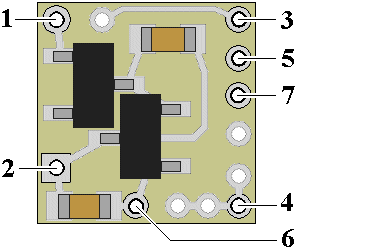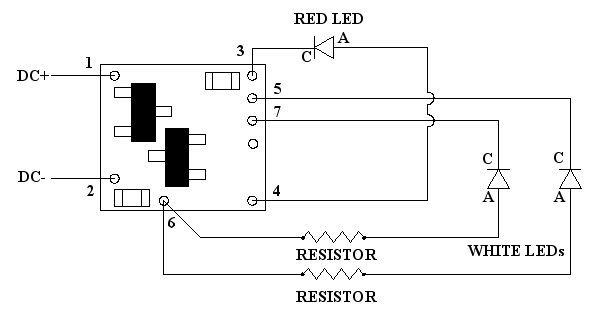Best viewed using:
Internet Explorer
or
Mozilla Firefox
N8062 Navigation Simulator Effect and Installation
Description of Lighting Effects
This simulator is programmed to run a red LED beacon (varies in intensity to simulate rotational effect), and 2 white LEDs configured as strobes for wingtips. Timing of the beacon is approximately once per second, and after every second cycle the strobes pulse for a short 25ms burst. This mimics many tail beacons and wingtip strobes seen on WW2 and modern aircraft.
Connecting the N8062
Installing the N8062 is very straightforward. Its tiny size and thin construction will allow it to be placed nearly anywhere in any scale model. Because the module has circuitry on both sides, care must be taken to be sure that the components or wires soldered will not make contact with any metal object causing a short circuit.
The N8062 can be powered by battery or any well-filtered and regulated DC power source with an output of 6-18VDC.
Included with the module are two 6” lengths of #32 insulated wire. If necessary, these can be used for power input wires.
Solder point #1 is the + DC power connection as shown in Fig. 1.

Figure 1
Important note: A low-wattage iron with a pointed tip should be used for connection of wires. Too much heat or solder can easily damage the wires or module and void the warranty.
Also, all connecting wires should be pre-tinned before soldering them to the module. This will make connection quick and easy and ensure excessive heat is not applied to the solder points.
Solder point #2 is the -DC (or ground) power connection.
Connecting LEDs
When connecting the LEDs, proper polarity must be observed. LEDs are “polarity sensitive” and will not function if connected backwards. The N8062 is configured to allow connection of one 20 ma red LED with a device voltage of 1.75-2.0 volts DC (Ngineering’s Micro and Nano red LEDs, as well as many red LEDs available). This LED will use the on-board current limiting resistor so they can be wired directly. Two additional LEDs will be connected using external current limiting resistors (supplied).
Using wire appropriate for the size of the LEDs and its placement in the model, connect the red LED to the simulator module as shown below. Connect the cathode wire (the – connection) of the LED to point 3 on the module and connect the anode wire of the pair (the +) to solder point 4.
The next two (2) LED connections will be for the white strobe lights. Each LED must be wired with an external resistor in series to limit the current flow through the LED. These two LEDs cannot be wired as a series pair due to their combined higher device voltages so each must use its own resistor. Included with this module are several 1/8-watt surface-mount resistors (we’ve included a spare just in case). These resistors are tiny for easy placement and have pre-tinned tabs so soldering is easy. The first white LED’s cathode is to be wired to solder point 5 on the module. The resistor should be wired in series between this LED’s anode and point 6. The second white LED's cathode is to be wired to solder point 7 on the module. The resistor should be wired in series between this LED’s anode and point 6. See Fig. 2 below for a complete overview of wiring.

Figure 2
Once again, be sure to use a low-wattage soldering iron when connecting wires to the module. Our N40M2 12-watt Iron with either the N408I (iron clad) Needle Tip, or the N408X (bare copper) Needle Tip would be an excellent choice for this operation.
This completes connection of the N8062 module. It is recommended that a thorough re-inspection of all connections and module placement be performed prior to applying power to your model. We hope you enjoy the added realism our module provides.
© 2008 Ngineering





















